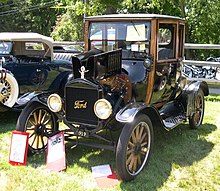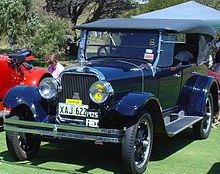Classic cars are better than vintage cars ? Is this true

1919 Ford Model T coupe

A restored 1925 Flint touring car (U.S.A.) at a rally in Australia

1929 Pierce-Arrow

1930 Cadillac V-16 452 Sport series phaeton
A vintage car is, in the most general sense, an old automobile, and in the narrower senses of car enthusiasts and collectors, it is a car from the period of 1919 to 1930. Such enthusiasts have categorization schemes for ages of cars that enforce distinctions between antique cars, vintage cars, classic cars, and so on. The classification criteria vary, but consensus within any country is often maintained by major car clubs, for example the Vintage Sports-Car Club (VSCC) in the UK.[1]
History
The vintage era in the automotive world was a time of transition. The car started off in 1919 as still something of a rarity, and ended up, in 1930, well on the way towards ubiquity. In fact, automobile production at the end of this period was not matched again until the 1950s. In the intervening years, most industrialized countries built nationwide roadsystems with the result that, towards the end of the period, the ability to negotiate unpaved roads was no longer a prime consideration of automotive design.
Cars became much more practical, convenient and comfortable during this period. Car heating was introduced (progressing from hot bricks via double-skinned exhaust manifolds to the heater radiator matrix),[2] as was the in-car radio.[3]Four-wheel braking from a common foot pedal was introduced, as was the use of hydraulically actuated brakes.[4]
United States Perspective
Towards the end of the vintage era, the system of octane rating of fuel was introduced, allowing comparison between fuels.[citation needed] In 1923 the gasoline additive Ethyl made its debut at the Indy 500that resulted in a boost in octane from the 1950s to the 1980s[5] In the United States drive-in restaurants were introduced as well as suburban shopping centers and motels.
Alfred P. Sloan and Harley Earl of General Motors, and Walter P. Chrysler capitalized on advertising the automobile's role in the life of the consumer for more than just the utilitarian value compared with the horse. The stock market crash of 1929 started the layoff of automotive workers and many new companies went bankrupt but over two million cars were still produced in 1929 and 1930.[6]
United States Federal road and highway acts
The Federal Aid Road Act of 1916 was the first federal highway act. War and lack of funding hampered any positive results of this act. The Federal Aid Highway Act of 1921 (Phipps Act) started a 50/50 matching fund to states for road building and resulted in the creation of new and improved roads. During this period as well as the car adapting to society, there were better roads, and society began to adapt to the car. Dwight D. Eisenhower participated in the highly publicized Transcontinental Motor Convoy in 1919 and after becoming President the experience influenced the Federal Aid Highway Act of 1956 that included 41,000 miles of highways.
Depression of 1920-1921
The end of World War I brought about the "Depression of 1920-21" with an inflation rate of over 20 percent, a 7 percent Federal Bankdiscount loan rate, and an 11.7 percent unemployment rate, that resulted in many companies going bankrupt and the automotive industry was decimated.[7]
Industry rationalisation
From 1919 to 1929, many dramatic changes took place. General Motors went into a financial crisis that lasted until after Alfred Sloan became president in 1923. Hudsonproduced the Essex in 1919 that, by 1925, had propelled the company to third in total sales behind Ford and Chevrolet.[8] Ford was in the process of building a new plant, buying back stock, and began an 18-month process of tooling-up to replace the Model T with the Model A in 1927. In 1921 Maxwell failed and Walter P. Chrysler, formerly of General Motors, was brought in to reorganize it and, in 1925, the Chrysler Corporation was formed. With Ford out for a period, Chrysler was able to produce and market the low-priced Plymouthin 1928, and bought out the Dodge Brothers, also in 1928, resulting in "The Big Three" more recently known as the "Detroit Three".
There were other automakers that made it past the 1920-1921 depression only to fail during the Great Depression.
Europe
During the Great Depression, in Britain many small companies started in the post World War I boom failed or merged leaving six[citation needed] major manufacturers: Morris, Austin, Standard, Singer, Ford of Britain, and General Motors Vauxhall. A similar boom-and-bust cycle was seen in mainland Europe.[citation needed]
Safety issues
Antique automobiles and early to middle era[when defined as?] classic cars do not have the safety features that are standard on modern cars. The most rudimentary of safety features, front wheel brakes and hydraulic brakes, began appearing on cars in the 1920s and 1930s respectively

Wow
ReplyDelete